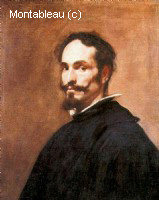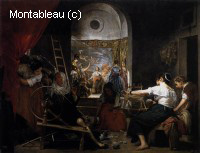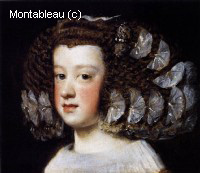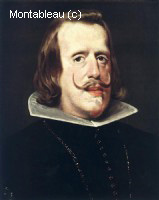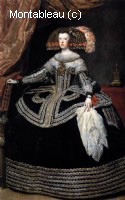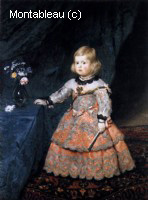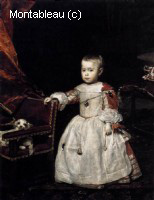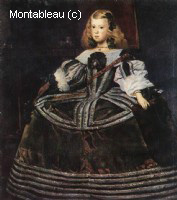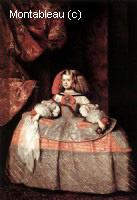
Velazquez Diego
"ANECD0TES HAVE their own truth, deeper, often, than the bare historical truth that would be theirs if the events they pretend to record in fact took place. It is a matter of historical truth that Velazquez painted the great portrait of his slave and assistant, Juan de Pareja, during his second sojourn in Italy. Pareja was a Moor of an "odd color" according to an early biography of Velazquez, who was his master in two senses of the term. The anecdote is this: Before exhibiting the painting, Velazquez, had Pareja himself carry it around to some influential Roman acquaintances. "They stood staring at the painted canvas, and then at the original, with admiration and amazement, not knowing which they should address and which would answer them." Perhaps it was because Pareja was a slave that Velazquez, selected him as a subject, for it provided the singularly theatrical opportunity of having Pareja show up at someone's palazzo bearing his own likeness. The anecdotal truth is this: Velazquez, meant to dazzle - not just show what he was capable of, but do so in a way calculated to amaze. He was a master of conceptual drama. "The Roman acquaintances murmured, of course, the obligatory compliment that one would have believed the painted head could talk - something people said about painters at the very dawn of illusionism. For Velazquez, it was not the right compliment. He was not bent on illusion and in fact had some sense of his limitations in bringing illusions off. What he meant to show was what he could do with paint; it was essential to the shock that it be perceived as paint and not misperceived as flesh. Consider the wide lace collar Pareja is shown wearing, a form of luxurious ornamentation then forbidden by the sumptuary laws of Spain. The critical question is: Why did Velazquez paint his slave in this expensive accessory? The answer once more is: to dazzle. Viewers were meant to be astounded that anyone could generate out of visible flecks and dabs of white paint a lavish confection of lace. At no point was illusion a possibility. Nobody, looking at Pareja's mop of hair, would think it real hair. Everyone would see it as smudges of paint of indeterminate color that, without giving up their identity as paint, miraculously became the wiry coiffure of an exotic man. Or again, out of strokes that defy analysis, the artist achieved a velvet sleeve. "Velazquez, was, after all, seeking commissions. Specialists say that it was immediately after the Pareja episode that he did the magnificent portrait of Innocent X, one of Velazquez's many masterpieces, which the Metropolitan Museum of Art (owner of the portrait of Juan de Pareja since 1971) was unable to secure for its nonetheless spectacular exhibition of this transcendent genius. In the papal portrait, once again, without paint ever concealing itself as paint, are the white touches that shimmer as lace, as the shirred white garment the Pope wears under the cape of heavy crimson silk the painter has summoned out of sweeps and swags of pigment. And beyond even that is the fierce and crafty face of the throned Pontiff, Innocent by name but hardly by nature, peering out from the corners of his eyes at a difficult and treacherous world he is shifty enough to master. "The anecdote, if my reading of it holds, yields an explanatory hypothesis for a good many Velazquez paintings. Think, for particular example, of the astonishing Old Woman Cooking Eggs, done in 1618, when Velazquez, was nineteen. It is one of the so-called bodegón works, domestic scenes in which it often seems as if the human beings are of secondary importance to the pots and pans and ladles arrayed on rough tables or suspended from kitchen walls. There are two bodegones in the show, the other being the even more compelling Waterseller of Seville. Each of them is an exercise in virtuosity in which the artist has chosen objects in order to display his ability to overcome the difficulties of painting them. One question scholars raise is for whom the paintings were done, but my sense is that they were advertisements by an artist possessed of tremendous gifts and in search of commissions. So they were executed in the same spirit as the portrait of Juan de Pareja or the measurably less successful baroque paintings I shall discuss below, evidently done on speculation, since they were sold to the King of Spain: to display Velazquez's mastery of the Italian technologies of illusion. "Old Woman Cooking Eggs shows a variety of substances, selected in part to demonstrate the artist's ability to paint them convincingly: copper, brass, pottery both glazed and unglazed, straw, pewter, linen, the skin of onion and melon, the human eye, wood, eggshell, string, and glass. The ceramic casserole is tipped up so we can admire the artistry of painted egg whites in varying stages of opacity. There are fewer substances in Waterseller, but in compensation there is the stunning virtuosity exhibited in the discoloration of the immense jug, due to misfiring in the kiln, and the way the clay looks when water trickles down its sides. "Both paintings are redeemed from mere boasting in the medium of paint by an extraordinary sense of mystery, as if the works had deep intelligence to communicate in the notation of humble utensils. Thus the objects in Old Woman Cooking Eggs have an almost otherworldly luminescence - the light source comes from in front of the picture plane, highlighting the objects without illuminating the room, which is in the darkest of shadows behind the two figures. Each of these, the old woman and the boy, seems caught up in some meditation, and almost arrested in mid-action. The boy holds a heavy, trussed melon with one hand and a glass cruet, perhaps of oil or of wine (each of them a ritual fluid), with the other. The woman and the boy are connected by their obliviousness of one another. The woman holds a spoon poised over the pan in one hand and an uncracked egg in the other, as the whites thicken beneath. It is as if the kitchen were a scene of otherworldly intervention or mystic visitation. In Waterseller the old man and the boy have hold of the base and stem of the water glass, respectively, but otherwise have no contact. Why is the glass in fact an ornamental goblet of intricate workmanship? And why does it contain a fig? The fig-bearing goblet is overdetermined; it enables Velazquez to dazzle and puzzle us at once. I am not sure this or any of his puzzles are meant to be solved so much as merely felt. The paintings seem to me to have as part of their content the mysteries they transmit. And I think as well that the intermixture of mystery and mastery, each uncanny in its own but connected way, defines Velazquez's project throughout his career, down to Las Meninas, which to this day defeats learned interpreters. Cunning man: it is as if he assured his immortality by frustrating an understanding that seemed at once urgent and inaccessible. "Let us now examine the baroque tableaux Velazquez executed on his first and, one might say, apprentice expedition to Italy, where he went to learn from masters who had nothing to teach him the next time he visited. These are striking partly because of their discontinuity with his overall style, due to their artificial theatricality and their organization of space. Velazquez has deployed gesticulating figures in a stagelike setting in relatively clear interior illumination, hence without the odd shadows that contribute to the portentousness of the bodegones. These are Joseph's Bloody Coat Brought to Jacob, in which the wicked brothers, appropriately scolded by a wise spaniel, pretend grief before their shattered father; and The Forge of Vulcan, in which a radiant Apollo informs Vulcan that his wife, Venus, is making out with Mars. In these efforts Velazquez is trying to be an Italian master, and it is instructive to see how clumsily he handles perspective, especially in the Joseph painting, where he utilized the kind of checkerboard tiles standardly employed to facilitate an illusion of orderly spatial recession. The stunned Jacob is shown rising from his seat on a carpeted dais, but Velazquez somehow cannot get the carpet to lie flat on the floor, or the walking stick to lean convincingly against the platform. Each painting is filled with stunning detail, such as the brilliant pitcher on the mantelpiece in Vulcan's workshop, which even so does not get transfigured in the way the objects in the bodegones do, emerging from the dark like angelic presences. I am insufficiently a scholar to say with certainty that Velazquez never attempted Italianate spaces again, but my sense is that he recognized that certain effects made possible by perspective lay outside his repertory of bewitchments. This is worth mentioning on two counts. First, reconstructions of alleged perspective in Las Meninas have, since Foucault, played a considerable role in the various "solutions" to the painting, when it is doubtful Velazquez, could use perspective with the required precision. But second, we can appreciate how he deepened his work by finding a way around this curious ineptitude. "Compare the two remarkably similar portraits of his patron, Philip IV, owned by the Metropolitan and the Prado. They must have been done, judging from the King's features, at very nearly the same time. I conjecture that the Metropolitan portrait is earlier because Velazquez had not yet discovered the solution that was to enhance the mysteriousness I consider an intended effect of his work. Each portrait shows the King standing next to a chest, on which he has placed his authoritative and emblematic hat. In the Metropolitan version there is a horizontal line to mark where floor meets wall, implying the space of a room. This line has in effect been erased in the Prado version, where the tonalities of wall and floor are indistinguishable, so that the King is now placed in an undifferentiated space, spiritual rather than geometrical, almost fluid, with shadows floating like the ink emitted by cuttlefish. Velazquez as far as I know, invented this kind of space, and used it to great effect in his standing portraits, most stunningly in his study of the jester Pablo of Valladolid (not in this show). The jester is poised in undifferentiated space, alone with his shadow, which gives the space an intensity ordinarily dissipated in the royal portraits, where the subject co-occupies the space with some appropriate symbol of power - at the very least a table on which to place a hat or a chair on which to rest a possessing hand. A jester has no such authority, which is what gives him his power: Pablo almost wears his empty space like a visible soul and becomes in consequence monumental. Manet thought Pablo de Valladolid perhaps "the most astonishing piece of painting ever done." The undifferentiated space in which shadows float became natural for Manet and Degas to use - though for neither of them was mathematical perspective either a problem or a solution - and it found its way into portrait photography as a common device for lending presence to the face and features of the subject. "There is another anecdote concerning Juan de Pareja. Because Pareja was a slave, Velazquez - "for the honor of art" - refused to allow him to have anything to do with drawing or painting as such, restricting him to the grinding of pigment or the priming of canvas, as if a drawing by a slave would be a perversion of art. (I recall an episode in Elvira Madigan in which the starving performer seeks to sell a portrait of herself by Toulouse-Lautrec, only to be told that drawings by dwarves are worth very little.) In any case, Juan de Pareja learned to draw and paint, and the anecdote has him placing one of his own paintings where the King ordinarily would have expected to see the new work of Velazquez, If the King were to admire the work, believing it to be by Velazquez he would, in consistency, be acknowledging parity between slave and master. The mathematician Alan Turing proposed exactly such a test in connection with machines: if the only plausible explanation of a given output is that it is due to intelligence when coming from a human, then consistency would require ascribing intelligence to a machine whose output is identical. The King in effect endorsed the Turing test by saying to Juan, "Be advised that any man that has this skill cannot be a slave." "It must be appreciated that with the discovery of the New World there was a raging question in Spain whether, as a Christian nation, it could rightly enslave the Indians encountered there. One strategy was to revive the Aristotelian argument that there exist natural slaves, and while indeed it may be unchristian to enslave a human being, natural slaves are not human, but merely tools. The issue was debated at the faculties of Salamanca and Valladolid, and against this background the King's emancipating remark takes on a certain profundity. If there are natural slaves there are natural masters. The ability to paint like Velazquez marks a metaphysical superiority. It sometimes is said that painters were mere artisans in the social hierarchies of Spain, but the anecdote suggests that this cannot have been altogether true in the royal household. There was a profound bond between monarch and painter. The immense privileges the King secured for Velazquez stand as evidence of this, given the obstacles even the King had to deal with to do so, and I think this recognition of his natural nobility had to mean a great deal to this artist. So in painting he was doing more than displaying unmatchable gifts. He was claiming high position in the stratified universe of divine rulers and natural slaves. So it perhaps really did become less important to him to make paintings when acknowledgment of his true position came through such recognitions and rewards. To us this seems the wrong order of values; but that only measures the distance between his world and ours. "There is a great difficulty in finding our way into a world in which dwarves and fools and jesters have a dignity and meaning we cannot altogether fathom, or in which a queen's handkerchief is almost as interesting as she is. And who knows how to read the marvelous dogs? There is a portrait, not shown in this exhibition, of Prince Felipe Próspero, the hope of his country, who died before reaching age four, despite the arsenal of amulets draped around his pinafore. Felipe's hand is resting on the back of a velvet chair as a sign of status and power. In an earlier portrait of Dona Antonia de Ipenarrieta, that lady also has the privilege of resting her hand on a chair, showing that she has the right to be seated while others stand. On Felipe's chair lolls an adorable dog, its tail hanging insouciantly over the edge, its witty, dark eyes engaging us in some complicit way. Given the heavy meaning of the chair in the rigid semiotics of courtly etiquette in Spain, something is being conveyed beyond the fact that spoiled dogs could climb onto furniture in which courtiers would not dare sit. Some metaphysical joke? Or the suggestion that dogs hold some rank in nature higher than slaves or even certain courtiers? All I know is that a dog in a chair is not innocent naturalism. One has the sense, in fact, that everything means something awesome, which intensifies the pleasure one takes in this tremendous painter we know we will never fully understand." - From Arthur Danto, "Embodied Meanings"
See more
